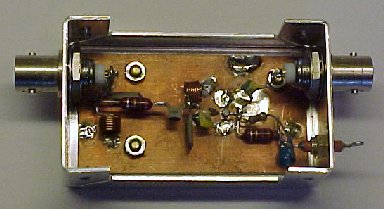Design of a preamplifier for the "deaf" HF receiver. When you need extra sensitivity for 15, 12 and 10 meter operation - for example for amateur satellites.

Background
This simple little amplifier is using a MMIC MAR-6 form MiniCircuits to give 20 dB gain with about 3 dB noise figure, across 21 - 30 MHz. Selectivity is set by a 21 -30 MHz BPF at the input.
The mechanical design
The amplifier is build on a double sided board measuring 32x60 mm. The copper side functions as a ground plane and all components are mounted free standing.The board is then screwed into a small metal box with BNC connectors.

The circuit
The diagram shown is below. The input is a no-tune band pass filter using standard components, plus two hand wound coils.The filter is designed to have 50 ohm in- and output impedance directly at the top of the two parallel circuits.
The MMIC amplifier is powered from +12 V through a 560 ohm drop resistor and the output is broadband.

Layout
The component layout is shown here. Input to the left.

(The photo shows two components in the lower right corner, which are not on the diagram. They are a 4.7 uH RFC and a 3.3 uF capacitor used originally for DC feeding the MMIC. However the 560 ohm resistor solution worked just as well! - but I left them on the PCB and the RFC is still connected to the MMIC output pin.)

Tune up
Being a no-tune amplifier there is nothing to adjust. Just measure the DC current. Abt. 16 mA is fine.
Performance
The performance of this amplifier is to a large degree set by the MMIC. With MAR-6 the datasheet says 3 dB noise figure and a 3'rd order intercept point of +14.5 dBm. The BPF determines the overall gain, which can be seen on the picture.

It is very important that the gain drops off rapidly to the low frequency
side, otherwise strong signals from 15 MHz and downwards could generate
harmonics and mixing products falling into the 21 to 30 MHz range.
The band pass filter was selected to have a steep low frequency skirt.
Possible changes
The amplifier can be build using other MMIC's. For this applications you should look for medium gain (15 - 25 dB), low noise figure and a 3'rd order intercept point of at least +10 dBm.Beware that manufacturers uses different ways to mark in- and output!
Back to OZ2OE homepage.